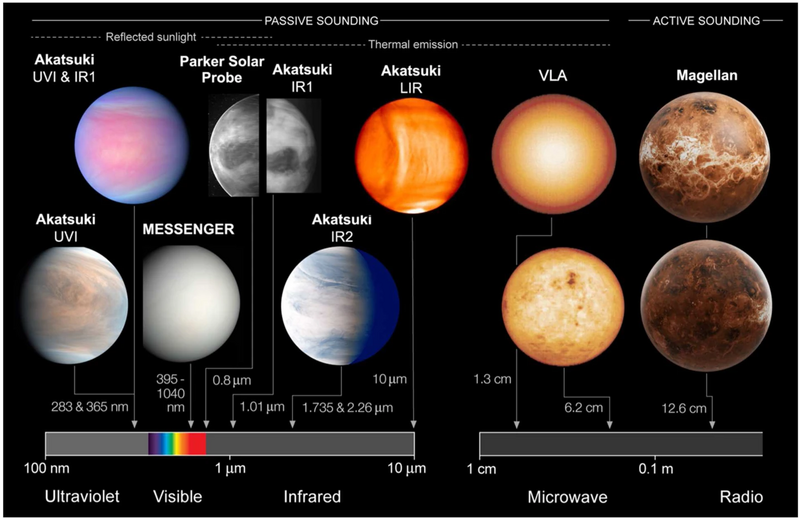File:11214 2023 956 Fig3 HTML.webp

Size of this PNG preview of this WEBP file: 800 × 520 pixels. Other resolutions: 320 × 208 pixels | 640 × 416 pixels | 1,024 × 666 pixels | 1,434 × 932 pixels.
Original file (1,434 × 932 pixels, file size: 99 KB, MIME type: image/webp)
File information
Structured data
Captions
Captions
Venus imaged in different wavelengths and methodes.
Summary
edit| Description11214 2023 956 Fig3 HTML.webp |
English: "Venus looks bland in nearly all the visible wavelengths—but other wavelengths reveal myriad details. From left to right: dayside false color image from Akatsuki’s UVI instrument (PLANET-C Project); dayside false color image from Akatsuki’s UVI and IR1 instruments (PLANET-C Project); composite of dayside imagery from MESSENGER that shows natural color (NASA/JHUAPL/CIW/ Gordon Ugarkovic); nightside image from PSP centered on Ovda Regio (Wood et al. 2022); nightside image of the same area from Akatsuki’s IR1 instrument, but rotated (PLANET-C Project); nightside synthesized false color image from Akatsuki’s IR2 instrument (PLANET-C Project); stack of five pseudo-color infrared images from Akatsuki’s LIR instrument (PLANET-C Project); microwave observations from the Very Large Array (Butler et al. 2001); and a surface 3D model derived from Magellan radar imagery (NASA Visualization Technology Applications and Development). Images at shorter wavelengths are made using sunlight reflected from the dayside of Venus. Longer-wavelength images record thermal emission from the surface and/or atmosphere. Finally, the radar images show the power of active sounding to reveal surface features"[1] |
| Date | |
| Source | https://link.springer.com/article/10.1007/s11214-023-00956-0/figures/3 |
| Author | O’Rourke, J.G., Wilson, C.F., Borrelli, M.E. et al. |
Licensing
editThis file is licensed under the Creative Commons Attribution-Share Alike 4.0 International license.
- You are free:
- to share – to copy, distribute and transmit the work
- to remix – to adapt the work
- Under the following conditions:
- attribution – You must give appropriate credit, provide a link to the license, and indicate if changes were made. You may do so in any reasonable manner, but not in any way that suggests the licensor endorses you or your use.
- share alike – If you remix, transform, or build upon the material, you must distribute your contributions under the same or compatible license as the original.
- ↑ O’Rourke, Joseph G. (2023). "Venus, the Planet: Introduction to the Evolution of Earth’s Sister Planet". Space Science Reviews 219 (1). Springer Science and Business Media LLC. DOI:10.1007/s11214-023-00956-0. ISSN 0038-6308.
File history
Click on a date/time to view the file as it appeared at that time.
| Date/Time | Thumbnail | Dimensions | User | Comment | |
|---|---|---|---|---|---|
| current | 21:57, 6 July 2023 |  | 1,434 × 932 (99 KB) | Nsae Comp (talk | contribs) | Uploaded a work by O’Rourke, J.G., Wilson, C.F., Borrelli, M.E. et al. from https://link.springer.com/article/10.1007/s11214-023-00956-0/figures/10 with UploadWizard |
You cannot overwrite this file.
File usage on Commons
There are no pages that use this file.
File usage on other wikis
The following other wikis use this file:
- Usage on bn.wikipedia.org
- Usage on en.wikipedia.org